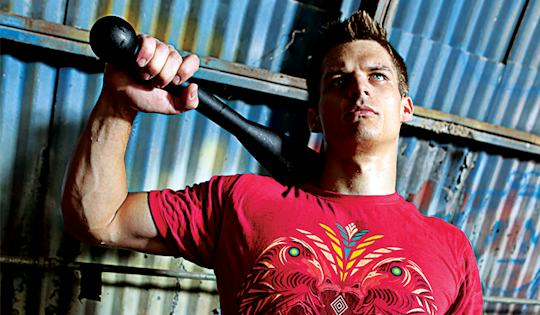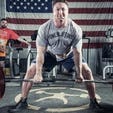Steel Clubs and Kettlebells are both useful in the pursuit of improved fitness and lifelong health. Both tools have a myriad of benefits, ranging from developing strength and endurance to highly demanding and complex movement patterns that have huge carry over to specific sports or activities. They can safely increase your range of motion under load or even relieve some stress by satisfying the primal thrill you get as you hoist and swing these implements around. The list of benefits is extensive, but the bottom line is, they are both awesome and fun as hell to play with!
Steel Club/Kettlebell Difference #1: Weight Distribution & Grip
The first very noticeable difference in Steel Clubs and Kettlebells is that both are odd shaped objects with an offset weight distribution. The individual shapes will provide their own unique challenges due to the grip placement required to use them, the displacement of the center of mass in relationship to the grip, and even the grip’s relationship to the earth.
For example, to hold a Kettlebell in the Rack Position, the center of mass will be resting a little on the arm while hanging below the handle and remaining close to the body. The handle itself is parallel to the earth, so the structure (skeletal system) is assisting in holding the load. A Steel Club on the other hand, has a handle that runs perpendicular (while being held upright or upside down) to the earth and can be grabbed either above or below its center of mass. With the weight above or below the grip and the perpendicular grip itself not allowing any structure to assist, it requires much more neurological activation to keep the Steel Club in position and under control.
A simple way to think about it is the difference in the feeling you get while climbing a ladder compared to climbing a rope. Now apply those concepts to a drill like the Overhead Press; it’s a completely different tax on the body; you have the weight sliding through the hands toward the ground as opposed to having the weight rested on a hard and bony surface.
Steel Club/Kettlebell Difference #2: Increasing & Decreasing Difficulty
Another major difference, which may not seem like much, is the incremental increase or decrease in load you can experience by holding the Steel Club further or closer to its center of mass. The Kettlebell’s center of mass will always be in the same spot, so that one weight can only be made more or less demanding by changing variables like tempo, rep count, and rest time. The micro adjustments made toward or away from the center of mass of a Steel Club allows one club to cover a wide range of perceived weight.
If you grab the Steel Club closer to the center of mass, the load decreases. Inversely, if you grab it further from the center of mass, the load increases. This can play a huge benefit for those wanting to get a very complete and intense training session with the option of increasing or decreasing the load at a moment’s notice without having to change tools or weights. One Steel Club can go a long way and satisfy a ton of fitness needs.
Steel Club/Kettlebell Difference #3: Shoulder Engagement
One major advantage that the Steel Club has is the ability to train each shoulder individually through behind your head, anti-extension, and swinging drills. The Kettlebell Halo exercise allows for a similar, controlled motion with the use of two hands, but pales in comparison to the full shoulder motion and strengthening accessible with the use of a safely guided 1-Hand Swing or Pull with a Steel Club.
The pulling force that has to be dealt with during a swinging or pulling motion puts a different load on the body. It has to resist the motion of the Steel Club as well as safely guide it, while “muscling” it into position. This is done while taking the shoulders safely through their major ranges of motion all while loaded in a pulling way that creates space in the joints, helping to lubricate them and improve their overall health and the health of the surrounding soft tissue. This requires the muscle to work just as hard as if it were under compressive load.
Not only can one achieve great upper body strength and endurance through swinging Steel Clubs, you can also achieve great joint health, increased range of motion, and an unbelievable grip that carries over into practical things like grabbing a person’s extended limb, just to name a few. Kettlebells do all of these things too, just not quite as thoroughly as with Steel Clubs.
Steel Club/Kettlebell Difference #4: 2-Hand Exercises
As you start to venture into two hand work with Steel Clubs, the uneven grip required to hold the Steel Club upright is instantly poses a unique activation. One hand being closer to the center of mass than the other requires you to activate a “push/pull” feel, akin to steadying a pistol, in order to keep it in position, which is slightly outside of your base of support. Having one hand over the other during the Arm Extension exercise creates a mechanical disadvantage and puts one shoulder slightly higher than the other, making the bottom arm difficult to lock, and the opposing shoulder difficult to stay down.
A similar concept happens as the Steel Club goes over the shoulder and behind the body (without the locking arm). The Steel Club can generally go over either shoulder no matter which hand is on top and switch from side to side, but whatever hand is on the bottom tends to be have a tougher time staying in place. As frustrating as the grip can be, these mechanical disadvantages can be used to address many neurological deficiencies and structural hang-ups that may be hindering a given area when the Steel Club exercises are performed correctly.
Steel Club/Kettlebell Difference #5: Versatility & Application
The numerous ways that you can hold a Steel Club (two hand work, single arm work, heavy end up, heavy end down, grip close together, grip far apart, alternating grip, grip closer to center of mass, grip further out, etc.) not only make for a wide variety and variations of movements and exercises to train, but also a way to develop exercises that apply to your sports and hobbies. For example, utilizing an exercise called the Pivoting Mill will help to develop the hip rotation and big toe pivot similar to a throwing a punch or using the same drill to help strengthen the shoulder and develop range of motion through a movement similar to pitching a ball.
All things said Kettlebells are fantastic. However, Steel Clubs just seem to have the decisive edge when it comes to versatility and a laundry list of health and fitness benefits to go with it.

)





